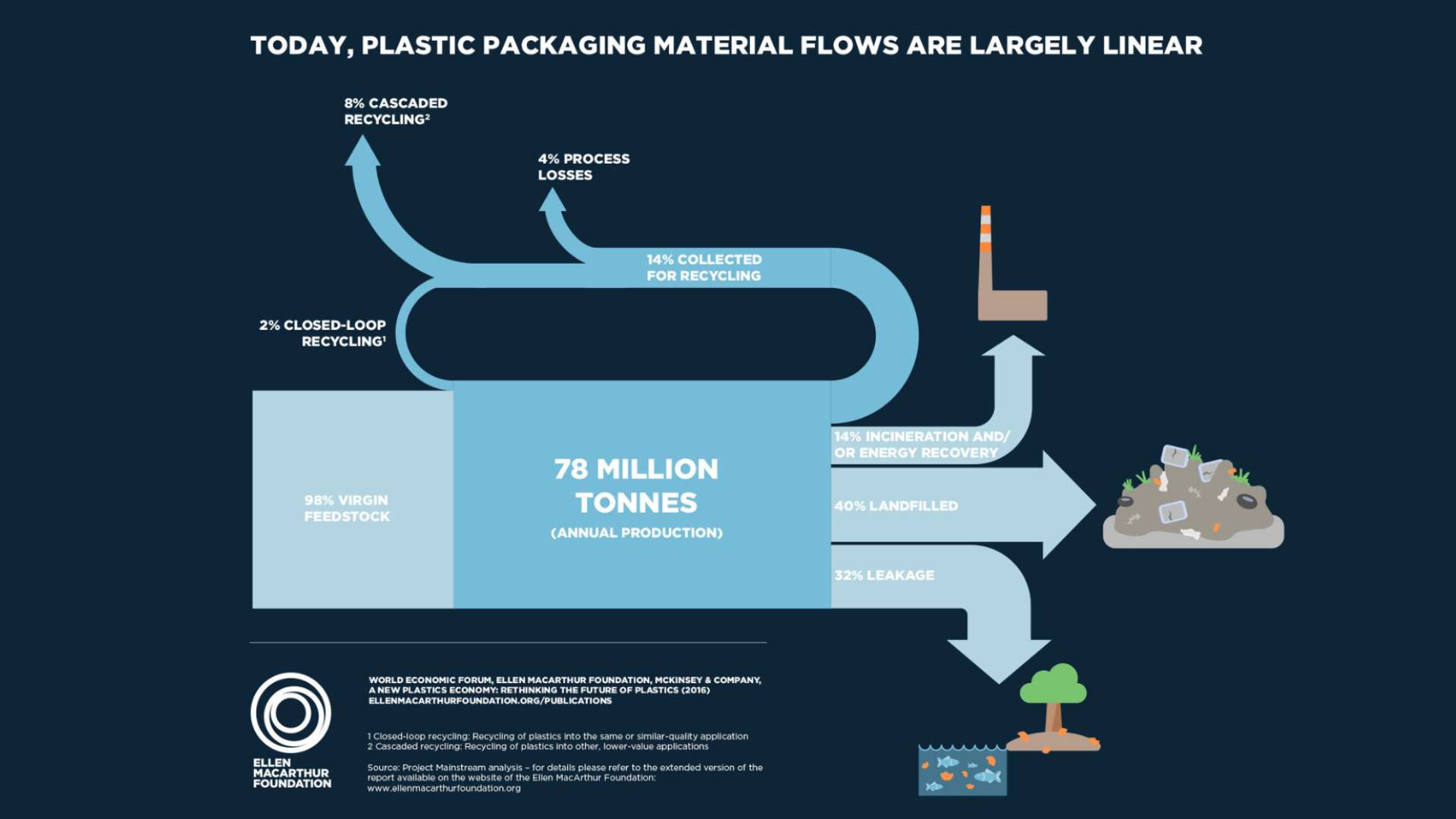- News & Insights
- 2022
- Learn how legislation and policies boost the circular economy for plastics
- Sustainability
- Regulations
News & Insights
Circular economy for plastics
Learn how legislation and policies boost the circular economy for plastics
According to the latest OECD report, only 9% of plastic is successfully recycled.
This means that the bulk of it ends up in landfills or is incinerated and leaks into the environment under the current “take, make and dispose” approach1. The UN Environmental Programme agency estimates that plastic pollution increased from 2 million tons in 1950 to 348 million tons in 2017 and is expected to double by 20402. Additionally, the UN agency foresees that greenhouse gas emissions associated with plastic production, use, and disposal will account for 15% of the global carbon budget by 20503.
Designing a circular economy for plastics is more important than ever. Underpin by the new 3R’s principles – reduce, reuse, and recycle, a circular approach means that plastics constantly flow in a closed loop system. As a result, resources in circulation are not wasted and the environmental impact is reduced. The new paradigm, however, necessitates shifting the focus from recycling as waste disposal toward conscious manufacturing. The international community and governments across the globe are stepping in to incentivize the transition. In March 2022, the United Nations announced its intention to introduce a global plastics treaty to address the full lifecycle of plastic including production, design, and disposal4. More than 170 countries have supported the initiative which will become legally binding in 20245.
Global and regional policies, legislative initiatives, and public-private partnerships are instrumental to deliver the change. Follow along to learn more about the recent initiatives aiming to strengthen the circular economy for plastics.
 According to Ellen MacArthur Foundation, currently, most of the plastic is incinerated, ends up in a landfill, or leaks into the environment
According to Ellen MacArthur Foundation, currently, most of the plastic is incinerated, ends up in a landfill, or leaks into the environment
Policies and legislation promoting circularity
As part of its plastic strategy adopted in 2018, the European Commission has set an ambitious target to recycle at least 55% of all plastic packaging waste by 20306. At the same time, the strategy contains a pledge that by 2025, ten million tons of recycled plastic would be used in the manufacturing of new products in the EU. Meanwhile, all plastic packaging placed on the EU market must be reusable or easily recycled by 2030. To make sure it happens, many counties introduced plastic taxes depending on the specific point of its lifecycle. Spain, Italy, and the UK apply the charge whenever non-reusable plastic packaging is produced (or imported). The European Union, on the other hand, charges a fee for each kilogram of plastic packaging waste that is not recycled at the end of life. All of that while ensuring that recycling is also profitable for business7.
Several US recycling-related policy initiatives are currently being discussed in Congress8. They build on many successful state-led initiatives. Earlier this year, for instance, California introduced legislation requiring all packaging in the state to be compostable or recyclable by 20329. In South America, Chile has recently introduced a ban on single-use plastic and pledged that 70% of the plastic collected and recycled in the country must be used in the manufacturing of disposable plastic bottles by 206010.
On the other side of the globe, Japan introduced a new law to strengthen its 3Rs strategy by promoting resource circulation at every stage of the lifecycle of plastics from design and manufacturing to discharge and collection11. Meanwhile, ASEAN countries are advancing their efforts in combating marine plastic pollution. Indonesia, for instance, set an ambitious target to reduce marine plastic waste by 70% by 202512.
Strengthening private–public collaboration for circularity
Policies and legislations are one way to boost plastics recyclability, another is to motivate governments and private businesses to work together for a greater cause. The European Plastic Pact, for instance, is a cross-border initiative bringing together over eighty governments, companies, and organizations from across the entire plastic value chain13. The Latin-American and Caribbean Circular Economy Coalition is focusing on eco-design and rebuilding the economy during post Covid-19 crisis with the 3R principles in mind. Similar initiatives have also been launched in Australia, New Zealand, and the Pacific Island (ANZPAC Plastic Pact)14, as well as in many countries across the globe, like Chile15, India16, South Africa17, the US18, or Canada19.

Another way businesses can demonstrate their commitment to conserving natural resources is to apply for recyclability certification. To increase the traceability of ocean-bound plastics (OBP), companies can apply for the global OBP Certification Program. It helps recognize that businesses collect and treat OBP in an appropriate and ethical way before it reaches the ocean20. Another good example of such a scheme is the EuCertPlast Traceability Program which recognizes companies that adhere to the highest standards and abide by local legislation while recycling post-consumer waste. The EuCertPlast certification aims to increase transparency across the European plastic value chain and determine the best recycling and trading practices21.

Nefab is committed to obtaining the EU CertPlast Traceability Certificate to provide full visibility to its consumers.
Circular economy for a better tomorrow
With the appropriate steps taken, the future does not have to be bleak. OECD estimates that a mix of fiscal and regulatory policies could cut plastic waste by as much as a third depending on the stringency of the implemented tools. Such changes would positively impact the environment, and the OECD foresees that all this could be achieved with minimal impact on the global GDP22.
We save resources in supply chains, for a better tomorrow.
Want to learn more?
GET IN TOUCH
Contact us to learn more about our sustainable solutions driving supply chains forward.
LEARN MORE
GreenCALC
Nefab’s own certified calculator measures and quantifies financial and environmental savings in our solutions
Sustainable Solutions
Engineered packaging for sustainable supply chains
Sustainable Materials
Fiber-based packaging and raw materials


